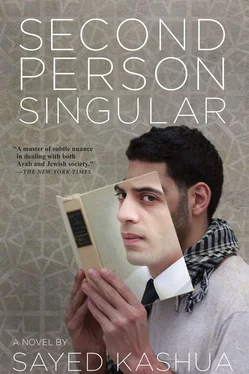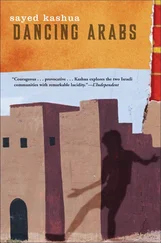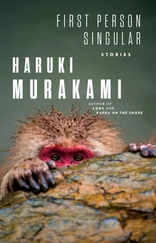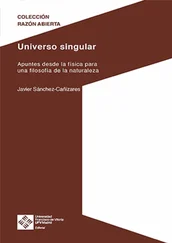I arrived at the square outside the mosque and knew that I had no intention of photographing old domes and other tourist attractions. People, that’s what I wanted to capture on film. I wanted to see if I could be as precise and knowing as Yonatan, if I could also take the kind of sharp, detailed pictures that revealed the entire world of the stranger on the other end of the lens.
The guards at the entrance to the square asked to see identification and let me in only once they’d verified that I was a Muslim. It was early, and between prayer times, so the square, which was usually full of careening kids who had nowhere else to play, was nearly empty.
A few beggars asked for spare change and I ignored them, knowing that if I coughed up a single cent I’d be hounded all the way out of the Old City, followed by their outstretched hands and sorry eyes.
“Excuse me,” a bearded man said, striding toward me with a walkie-talkie. “Wait,” he commanded and I stopped. “Are you a Muslim?”
“Yes,” I answered.
“Muslim,” he said, raising his radio to his mouth. “I’m sorry, your appearance was misleading. The camera made me think that maybe. . where are you from?”
“Jaljulia.”
“Welcome,” he said, bringing his palm to his chest.
I sat down on the stairs that led from the al-Aqsa square to the Mosque of Omar. I looked around and saw there was nothing that I really wanted to photograph. I opened the yellow envelope the Armenian had given me and took out the eighteen pictures from the previous roll of film.
I saw Yonatan, an eighteen-year-old Yonatan, standing on his own two feet. In the first photo, he held the camera that I now had around my neck. He had held it down around his waist and taken a picture of himself in the mirror in the attic bathroom, a sealed, sharp expression on his face. I flipped to the next picture: Yonatan, standing by the side of the bed. He held a release cable in his hand, the kind that lets you operate the camera from afar. The cable, I thought, wasn’t in the photo by chance. He knew what he wanted in his frames. In the third photo, he was standing on a chair in the middle of the room. In the next one, he threaded a rope through an anchor for the light fixture in the ceiling. I started breathing quickly, racing through the photos. He was in all of them. He tied the noose. He took a shot of himself from below. He moved the camera away and took a picture of himself testing the rope. And always the same expression, cold, emotionless, remote. He had taken a few different shots of himself, from various angles, with his neck in the noose. I felt starved for air. I stood up and tried to inhale properly, but still I could feel myself shaking. Yonatan stood on the back of the chair and in the last photo, number 18, I saw him push the chair away with his feet. Behind him, very vividly, I could see the bed and the pictures on the wall, but the center of the frame, where the body hung, was blurry, the neck, stomach, hands, and feet were all elongated, and I knew that he had used a slow shutter speed and a long exposure.
THE CARDBOARD BOX
I showed up half an hour early. There were two girls in the waiting room. Each had a big square art bag and they were chatting. They stopped their conversation for a second when I showed up, looked me over, and nodded in my direction. I nodded back, then lowered my eyes and went to check out the list of names on the door. I was number five.
“What time did they call you for?” one of the girls asked. She was skinny, with blonde hair that had been dyed purple.
“Eleven thirty,” I said.
“They’re running ridiculously late. The ten o’clock just went in now. How far down the list are you?”
“I’m fifth.”
“Cool, I’m fourth.”
“I’m sixth,” the other girl said softly. “After you.” She was more filled out than her friend and she wore a Ministry T-shirt. She noticed that I was staring at her shirt and lowered her eyes, and I, fearing she would think I was looking at her chest, said, “I have the same shirt.” She nodded and smiled. Her breasts were round and full and I could see the shape of her nipples through the fabric.
Each applicant had a half hour slot, and if the skinny one was right and the third on the list had only gone in now, then I had at least an hour until it was my turn. My first thought was to flee, to give up; what were the chances of me being accepted to the Bezalel Academy of Arts and Design? Knowing I didn’t belong, I sat down on the floor and leaned my back against the wall, opposite the girls.
“If the whole point of photography is to capture a single moment in time, I figured why not go for it, you know?” the skinny girl said. “I figured I’ll just go for it. I’ll photograph time. Or what time means to me.”
She picked up her portfolio, laid it on her knees, and started taking out photographs in black matte frames. I couldn’t see the photos she passed along to the other girl, one after another, carefully, as though handling the pages of a holy book. Every once in a while she blew dust off the surface of a photo and carried on with her presentation.
“To me this represents the passing of time, and here I tried to understand and conceptualize the meaning of the present, and here at the end I tried to capture the future as I see it, in other words, within the infinite space of time.”
The girl with the Ministry T-shirt seemed to find the skinny girl’s presentation interesting, and I knew there was no way I could carry on like that about time, and what’s more I realized that I had not framed any of my photographs. It was a mistake to come. I had no idea how I had ever made it through the first stage of the application process, but I knew for sure that I was not an artist. The Ministry girl glanced up for a moment and caught me looking at her. She smiled at me and I smiled back.
“And this is my self-portrait,” the skinny one said. “A woman with no head and no limbs.”
I made a face and just at that moment the Ministry girl looked up at me and burst out laughing.
“I’m sorry,” she said, trying to keep her poise. “I’m really sorry. He’s just making me laugh,” she said, pointing at me.
Several long minutes later the door opened and a young dark-skinned guy with long curly hair emerged. He was well-dressed, clothed from head to toe in designer apparel. He inhaled deeply and shut the door. The skinny girl hopped up.
“Well, what did they ask?” she clamored.
“You know, just questions about my work, where I’m from, why I want to study here, that kind of thing,” he said in Nazareth-accented Hebrew. The door opened again and a woman with a file in her hand summoned the skinny girl.
“Good luck,” the cute one said, and I mumbled after her, “Good luck.”
Just before the woman shut the door, the guy from Nazareth asked when he could expect results and she said within a month and then closed the door.
He was bursting with confidence. He said he had also applied to the department of architecture and that if he got in there he would definitely go, but that if he didn’t, he’d do a year of photography and then reapply to architecture at the end of the year.
“He definitely got in,” the Ministry girl said when we were left alone in the waiting room. “To photography and to architecture. They’ll probably fight over who gets him.”
“You know him?” I asked.
“No,” she said, shrugging, “but this is Bezalel. They’d kill to have an Arab in the program.”
“Maybe he has competition in the department of architecture,” I said, smiling.
“You’re right,” she said. “I hadn’t thought of that. Two Arabs is already too much.”
The skinny one walked out with a big smile on her face.
Читать дальше












